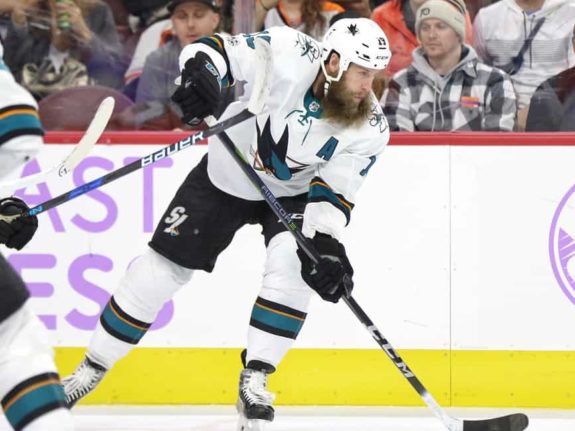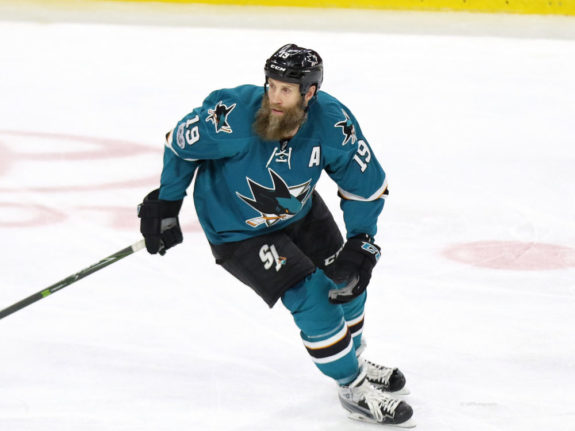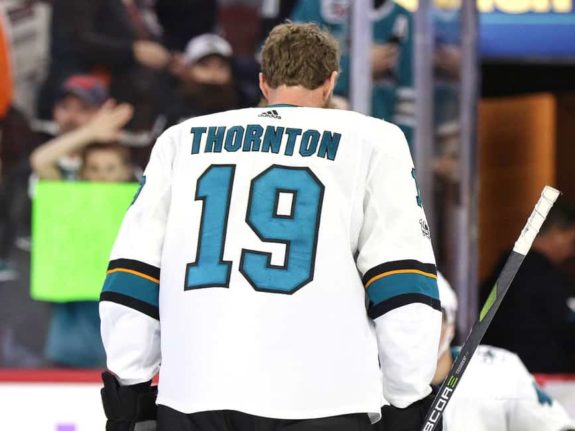In the process of covering the forwards for the San Jose Sharks, it became obvious one very special player needed his own piece. For the prior articles in this series the links are here:
- Main Points
- Forwards
- Joe Thornton
- Defensemen (up next)
There is simply no way to address the Sharks forwards without an in-depth discussion of Joe Thornton. The Sharks legend is dealing with past surgeries on both knees – one knee in April 2017, the other knee in January 2018. His future in the NHL and with the Sharks is up to him, but it will be challenging.
On top of this, he will become a free agent this offseason. If Thornton wants to play in San Jose next season, he’ll play in San Jose, management will make an effort to keep him. He says he wants to stay and this is the most likely scenario. But hardly the only one.
Jumbo says he definitely wants to return to @SanJoseSharks pic.twitter.com/RV8kVx9wWt
— Ross McKeon (@rossmckeon) May 8, 2018
Thornton’s Season
On the ice, Thornton’s season was less than many wished for, even before the second injury. He was coming off the April knee surgery and it was always unrealistic to suggest he’d be close to the player he once was, especially early in the season. The hope was he’d improve over the season as his repaired knee got stronger. Indeed, there were signs this was happening after an inconsistent start. But on Jan. 23, he tore the ACL and MCL in his other knee and his season ended.
In the 47 games he played, Thornton had a career-worst minus-9 and he will turn 39 in July. For the second straight season, Thornton wasn’t healthy or even close to it at season’s end. Retirement has to be a consideration, even if he’s implying it’s not. On top of all this, teams are increasing their emphasis on speed, the Sharks included. The NHL game is moving away from Thornton’s skill set.

Before the season, I asked, “What do the Sharks have in Thornton?” and suggested his productivity is similar to a third-line center. Thornton had six even strength goals and a dozen assists in 47 games. San Jose’s actual third-line center, Chris Tierney, had 14 goals and 19 assists in 82 games. Prorate Thornton’s numbers to 82 games and you get 10 goals and 21 assists; very similar to Tierney and there is a 15 year age gap between the two. Tierney turns 24 the before Thornton turns 39 in July.
Despite all this, Sharks head coach Peter DeBoer considered Thornton his 1C (top line center). It is hard to view him any other way, but he wasn’t the team’s best center this season, even when he was healthy. Still, there is one area where Thornton excelled: on the power play. While the top unit got off to a slow start, it hit its stride about a quarter of the way through the season. At that point, it sizzled.
The Sharks netted an average of a power-play goal per game over Thornton’s final 25 games (for reference, no NHL team has averaged a power play goal per game in the last eight full seasons). When Thornton went down, so did San Jose’s power play. Outside of the stretch of 25 power play goals in 25 games, the Sharks produced 28 power play tallies over the season’s other 57 games. The man advantage was literally twice as good with Thornton on it.
Free Agency
If he becomes a free agent (beginning July 1), he can sign with any team that wants his services. Every team knows Thornton isn’t the same player he was just two seasons ago when he was durable and elite. Now his play is more modest, he carries an increased likelihood of injury and his return to full health isn’t a given.

Thornton is a center, but how any face-offs will a team give to a player with two questionable knees? An NHL game geared toward speed includes rapid stopping and starting. How well can a large (he’s nicknamed Jumbo for a reason) 39-year-old man with problem knees fare in this evolving environment?
A team that wants Thornton must also know he will change the culture of the locker room. He is a great presence, but he’s also a very big presence. Not every team wants, or needs, new leadership. Thornton’s value on the open market is a big question.
This season, on a one year deal, Thornton earned $8 million. Some will say he was vastly overpaid and in a sense, they are correct. But the Sharks had cap space and rewarding the best player in franchise history without creating a cap space issue was both sound business and good hockey karma. There isn’t a question he’ll take less money to stay in San Jose. How much less is an unknown.
Thornton’s Historic Peers
Thornton sits very high on a bunch of all-time lists. A healthy Thornton could pass Mario Lemieux, Marcel Dionne and Gordie Howe on the all-time assist leaderboard before New Year’s Eve. But he won’t play to climb the leaderboard; he’ll play for the lone major accomplishment that has eluded him, the Stanley Cup. Do any serious Cup contenders have all the elements (and want to assume all the risks), including cap space, to entice Thornton? It’s possible. Sharks fans don’t need reminding that Patrick Marleau departed for greener pastures.
The Sharks have most of the same considerations as other potential suitors, but not all. The team has cap space, but it will go quickly if they land expensive additions including potential free agent John Tavares and current Shark, Evander Kane. There is a lot that can go right this offseason, especially if Thornton is willing to stay in San Jose for a modest cap hit.
Father Time and Joe Thornton
There is some good news in Thornton’s situation. The latest injury happened in January and even if it takes a full year to fully recover, it leaves plenty of time for him to make significant contributions and be healthy for next season’s playoffs. With the prior injury, he attempted to play in October following an April surgery. A shortened recovery timeline probably wasn’t in Thornton’s best interest, or the team’s. This will be less of an issue with this injury.
In 2015-16, Thornton’s line was a hot knife through butter and he was as good as any player in the league. His line was the only San Jose line that was plus on the season (and plus a lot), and the Sharks, essentially a one-line team, made it the Stanley Cup Final. Two years and a hockey lifetime later, Thornton is an open question. There is a lot more optimism than certainty when it comes to the answers. The good news is they are no longer dependent on Thornton to carry the team.

Obviously, Thornton is still very much the heart of the Sharks, emotionally if not physically, and beloved by the fan base. I have little doubt there are those with ticket plans who won’t be nearly as excited about a Sharks team without Thornton. For years, the dream of many fans was Thornton and Marleau lifting the Stanley Cup. Half the dream departed, we’ll see if the other half stays. In addition to everything else, the Sharks have good business reasons to want him back.
There is plenty of certainty in parts of Thornton’s future. Shortly after he retires, the Sharks will hoist his number 19 to the rafters of the Shark Tank and on another day not much further down the road, he’ll be inducted into the Hockey Hall of Fame. But between now and when he calls it a career, there are many questions. The answers, at least some of them, will come soon.